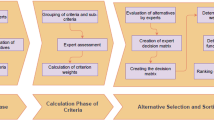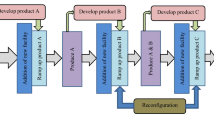Abstract
Smart manufacturing system must be designed based on a set of strategic objectives and a variety of surrounding environments; therefore, it includes a series of complex decisions and trade-offs between investment and profit. The MSDD based on the axiomatic design principle has an advantage on breaking down requirements and parameters and considering the relationships of them, but there is a limit to quantify relative weights of each requirement and parameter. To complement the limitation, a quantification method applying the analytic network process is proposed. The proposed method can calculate the relative importance degrees of the requirement and parameter objectively and help us understand and focus on more important factors of the smart manufacturing system design.






Similar content being viewed by others
References
Chryssolouris G (1992) Manufacturing systems: theory and practice. Springer, New York
Wu B (1992) Manufacturing systems design and analysis, 2nd edn. Chapman and Hall, London
Cochran DS, Arinez JF, Duda JW, Linck J (2001/2002) A decomposition approach for manufacturing system design. J Manuf Syst 20(6):371–389
Carrus BJ, Cochran DS (1998) Application of a design methodology for production systems. In: Annals of the 2nd International Conference on Engineering Design and Automation, July 1998, Maui, Hawaii
Neely A, Gregory M, Platts K (2005) Performance measurement system design: a literature review and research agenda. Int J Oper Prod Manag 25(12):1228–1263
Suh NP (1998) Axiomatic design theory for systems. Res Eng Design 10(4):189–209
De Toni A, Nassimbeni G, Tonchia S (1997) An integrated production performance measurement system. Ind Manag Data Syst 97(5):180–186
Cochran DS, Lima PC (1998) Lean production system design decomposition version 4.2. Internal working document of Production System Design Laboratory. Cambridge, MA: Massachusetts Institute of Technology
Cochran DS (1999) The production system design and deployment framework. In: Proceedings of the 1999 SAE International Automotive Manufacturing Conference SAE Technical Paper 1999-01-1644, May 1, pp 1–13, Detroit
Suh NP (1990) The principles of design. Oxford University Press, New York
Delaram J, Valilai OF (2018) An architectural view to computer integrated manufacturing systems based on axiomatic design theory. Comput Ind 100:96–114
Shao J, Lu F, Zeng C, Xu M (2016) Research progress analysis of reliability design method based on axiomatic design theory. Proc CIRP 53:107–112
Palleti VR, Joseph JV, Silva A (2018) A contribution of axiomatic design principles to the analysis and impact of attacks on critical infrastructures. Int J Crit Infrastruct Prot. https://doi.org/10.1016/j.ijcip.2018.08.007
Suh NP (2001) Axiomatic design: advantages and applications. Oxford University Press, New York
Togay C, Dogru AH, Tanik JC (2008) Systematic component-oriented development with axiomatic design. J Syst Softw 81:1803–1815
Saaty TL (2001) Decision making with dependence feedback: the analytic network process. RWS Publications, Pittsburgh
Chou Chien-chang (2018) Application of ANP to the selection of shipping registry: the case of Taiwanese maritime industry. Int J Ind Ergon 67:89–97
Becker Jarosław, Becker Aneta, Sulikowski Piotr, Zdziebko Tomasz (2018) ANP-based analysis of ICT usage in Central European enterprises. Procedia Comput Sci 126:2173–2183
Bard JF, Sousk SF (1990) A tradeoff analysis for rough terrain cargo handlers using the AHP: an example of group decision-making. IEEE Trans Eng Manag 37(3):222–227
Tang Xiaoli, Feng Junwen (2006) ANP Theory and Application expectation. Stat Decis-Mak 12(3):138–140
Yu R, Tzeng G-H (2006) A soft computing method for multi-criteria decision making with dependence and feedback. Appl Math Comput 180(6):63–75
Yüksel İ, Dagdeviren M (2007) Using the analytic network process (ANP) in a SWOT analysis—A case study for a textile firm. Inf Sci 177:3364–3382
Chang C-W, Wu C-R, Lin C-T, Lin H-L (2007) Evaluating digital video recorder systems using analytic hierarchy and analytic network processes. Inf Sci 177(16):3383–3396
Jung UK, Seo DW (2010) An ANP approach for R&D project evaluation based on interdependencies between research objectives and evaluation criteria. Decis Support Syst 49(3):335–342
Aragonés-Beltrán P, Chaparro-González F, Pastor-Ferrando JP, Rodríguez-Pozo F (2010) An ANP-based approach for the selection of photovoltaic solar power plant investment projects. Renew Sustain Energy Rev 14(1):249–264
Author information
Authors and Affiliations
Corresponding author
Rights and permissions
About this article
Cite this article
Jeong, HY. ANP-based quantification method for the smart manufacturing system design decomposition. J Supercomput 76, 6141–6157 (2020). https://doi.org/10.1007/s11227-018-2665-2
Published:
Issue Date:
DOI: https://doi.org/10.1007/s11227-018-2665-2




